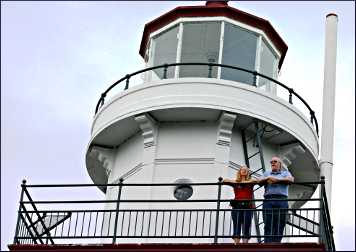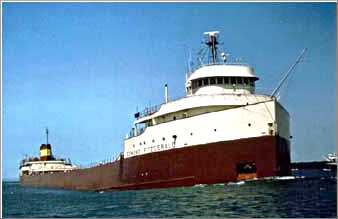Ghosts of the Great Lakes
Centuries of tragedy on ship and shore leave haunting memories.

© Beth Gauper
In late fall, ghosts go hand in hand with shipwrecks and the malevolent storms that cause them.
Crews and passengers have been coming to bad ends ever since boats sailed the Great Lakes, starting with the French explorer La Salle's Griffin, which disappeared in 1679 after leaving Washington Island in Door County and may have been found off Michigan's Garden Peninsula.
Some say the ship was done in by an Iroquois curse on the French invaders, and that it still can be glimpsed lurking in the fog.
Lonely lighthouses also produce ghosts. In northern Michigan, two of them hold haunted tours: Seul Choix Point just east of the Garden Peninsula, where a keeper died in 1910, and Ontonagon on Lake Superior, where a young woman died of diphtheria in 1885.
West of Marquette, another keeper was found as a skeleton hanging from a tree and is said to haunt Big Bay Point Lighthouse, now an inn.
It's easy to imagine ghosts at any time on clammy, cavernous freighters. But you won't be imagining them during Halloween season on the S.S. William A. Irvin in Duluth, which becomes a haunted ship, and the S.S. City of Milwaukee in Manistee, Mich., a train ferry that becomes the Ghost Ship.
Wisconsin port towns on Lake Michigan seem to produce more than their share of ghosts. You can join ghost walks in Milwaukee and Port Washington.
On the lakefront in Sheboygan, you can walk through the wooden hull of the Lottie Cooper, a three-masted schooner that sank in 1894 and was pulled up in 1992.
Nearby, a plaque tells of the Nov. 21, 1857 sinking of the steamship Phoenix; it burned to the waterline five miles off shore with more than 225 people aboard, including 175 Dutch immigrants headed for Sheboygan. Only 45 people survived.
The cold, vast Great Lakes have provided a library's worth of ghost stories for author Frederick Stonehouse, whose books include "Haunted Lake Michigan," "Haunted Lake Huron" and "Haunted Lakes."
He's also the author of "The Wreck of the Edmund Fitzgerald," one of many books that speculate about the causes of Lake Superior's most celebrated wreck. Once called the Queen of the Lakes, it sank during a vicious gale in 1975, off Whitefish Point on the east end of Michigan's Upper Peninsula.
Every Nov. 10, the Great Lakes Shipwreck Museum on Whitefish Point holds a service to commemorate the loss of the Fitz and its crew of 29, ringing the ship's salvaged bronze bell 29 times.
For more about the Whitefish Point area, see Graveyard of the Great Lakes.
On Minnesota's North Shore, where the Fitz was a familiar sight, the 29 names are read Nov. 10 at Split Rock Lighthouse and the beacon lighted.

© Beth Gauper
The lighthouse was built in 1910 in response to a 1905 November storm known as the Mataafa Blow, which sunk or damaged 29 ships on Lake Superior.
For more about the Mataafa and other shipwrecks on Minnesota's North Shore, see Gales of November.
The Fitzgerald left from the Burlington Northern ore docks in Superior, Wis., and went down 17 miles off the Michigan coast with 26,116 tons of taconite. The causes still are hotly debated.
Among the theories: The 729-foot boat hit a little-known reef and damaged its hull. Its steel and welds were overstressed from its years as a Great Lakes workhorse.
More theories: Faulty hatch covers allowed water to enter the hold. The ship was hit by the Three Sisters, a Lake Superior phenomenon in which two rogue waves strike, followed by a third massive wave that overwhelms the boat as it struggles to recover.
The Coast Guard, National Transportation Safety Board and Lake Carriers Association came to three different conclusions.
Nor'easters strike with particular ferocity on the North Shore, and some people make special trips to watch the waves during the gales of November.
Favorite spots (besides inside a warm cabin) include Canal Park or Kitchi-Gammi Park in Duluth, Stony Point on old Minnesota 61 between Duluth and Two Harbors, Sugarloaf Cove six miles south of Schroeder and Tofte Town Park in Tofte.
And many people like to visit Iona's Beach SNA, a Minnesota natural area, when the winds blow. It's known for the musical sounds it makes when thousands of smooth pieces of rhyolite "shingles" are lifted by waves and then fall back into place.
It's three miles east of Gooseberry Falls State Park.
For more, see Beaches of the North Shore.